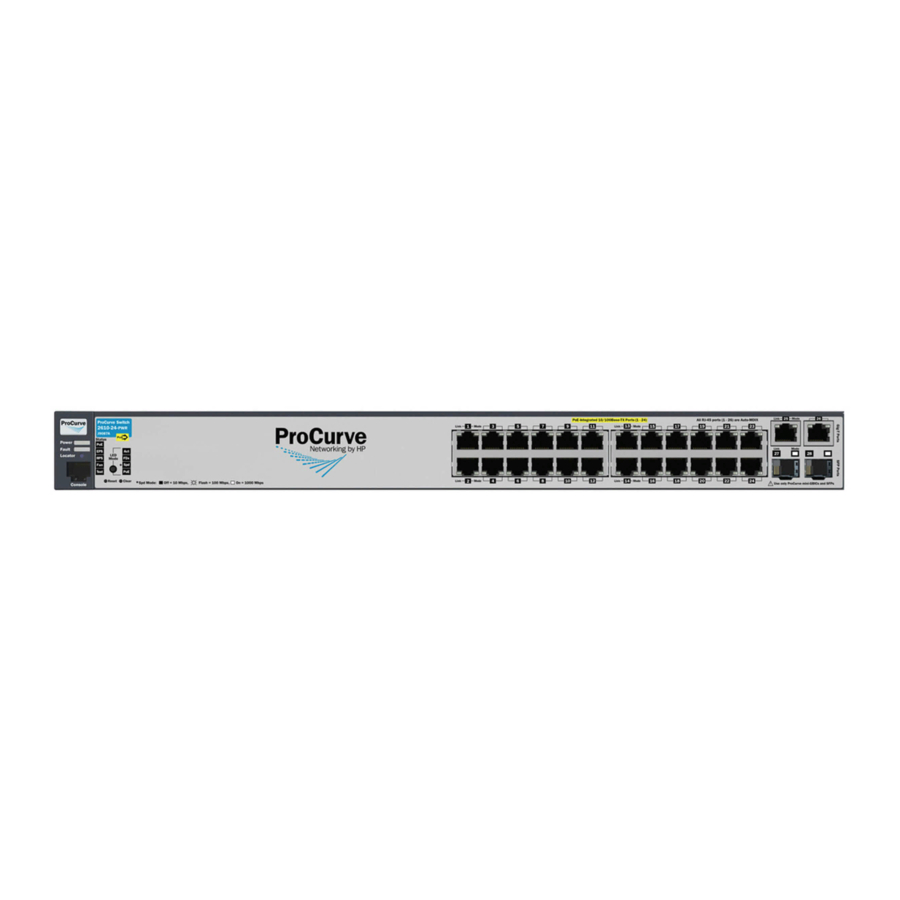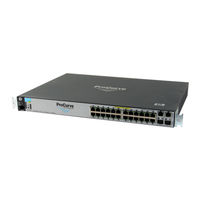
HP PROCURVE 2610-PWR Series Manuals
Manuals and User Guides for HP PROCURVE 2610-PWR Series. We have 2 HP PROCURVE 2610-PWR Series manuals available for free PDF download: Management And Configuration Manual, Advanced Traffic Management Manual
HP PROCURVE 2610-PWR Series Management And Configuration Manual (464 pages)
ProCurve 2610 Series ProCurve 2610-PWR Series
Table of Contents
-
-
Introduction26
-
Conventions26
-
Contents31
-
Overview32
-
Contents39
-
Overview40
-
-
-
-
Contents71
-
Overview72
-
Support URL83
-
Port Status87
-
-
-
Contents95
-
Overview97
-
Operating Notes116
-
Connected Host131
-
-
-
-
Overview150
-
IP Configuration151
-
File Downloads164
-
Contents169
-
-
9 Time Protocols
170-
Overview170
-
-
Configured191
-
-
-
Contents193
-
Overview195
-
Jumbo Frames209
-
Operating Rules210
-
Terminology210
-
Overview211
-
Troubleshooting216
-
Configuring UDLD232
-
Enabling UDLD233
-
Contents239
-
-
-
Overview240
-
Terminology241
-
Power Priority243
-
Contents257
-
Overview258
-
12 Port Trunking
258-
Link Connections259
-
Port Trunk Group266
-
-
-
Contents281
-
Overview283
-
Snmpv3 Enable287
-
SNMP Communities292
-
Trap Features300
-
Terminology305
-
Introduction309
-
LLDP Terminology310
-
Advertisements326
-
Overview340
-
How It Works346
-
Command Options347
-
Authentication348
-
Workstation349
-
Workstation350
-
Contents363
-
Overview365
-
CLI Access368
-
Menu Access368
-
CLI Access369
-
Menu Access369
-
CLI Access370
-
CLI Access371
-
Port Status371
-
Web Access371
-
VLAN Information381
-
VLAN Information382
-
Contents391
-
Overview393
-
General Problems397
-
Cli414
-
Debug Types416
-
Diagnostic Tools422
-
Using the CLI434
-
Contents439
-
Overview440
-
Advertisement
HP PROCURVE 2610-PWR Series Advanced Traffic Management Manual (364 pages)
Table of Contents
-
-
Conventions22
-
Introduction22
-
Contents27
-
Overview29
-
Preparation62
-
Port Trunks66
-
Contents67
-
Gvrp67
-
Overview68
-
Introduction69
-
-
Contents85
-
Overview86
-
IGMP Terms88
-
Enhancements89
-
-
-
-
Contents109
-
-
Overview111
-
RSTP (802.1W)116
-
Stp (802.1D)116
-
Overview119
-
Configuring RSTP121
-
STP Fast Mode138
-
Terminology141
-
Operating Notes152
-
MSTP Structure155
-
MST Regions157
-
Terminology160
-
Operating Rules162
-
Operating Notes189
-
Troubleshooting189
-
-
-
Contents191
-
Introduction193
-
Terminology196
-
Overview197
-
Introduction199
-
No Override211
-
-
-
IP Interfaces261
-
ARP Cache Table262
-
IP Route Table263
-
How ARP Works266
-
Configuring ICMP272
-
Configuring IRDP280
-
Overview284
-
DHCP Option 82286
-
Terminology287
-
Operating Notes298
-
Overview300
-
-
-
Overview309
-
Operation310
-
General Rules313
-
Specific Rules314
-
Commander Switch319
-
Switch321
-
Another Stack331
-
Status Messages353
-
Advertisement

